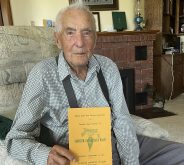A Holstein calf suckles from its mother while its twin, showing all the markings of a beef breed, lazes in the grass nearby.
The twins were born to a crossbred beef cow this summer. The beef calf was the result of artificial insemination. The Holstein calf resulted from an embryo transfer.
The calves are part of an effort started last year at Agriculture Canada’s Brandon Research Centre to learn more about managing cattle to produce twins.
Julie Small, a researcher at Brandon who specializes in reproductive management for beef cattle, said her work has potential advantages for beef and dairy producers.
Read Also

Alberta crop diversification centres receive funding
$5.2 million of provincial funding pumped into crop diversity research centres
The research has already resulted in some interesting findings – and some surprises.
Over the next decade, she and other researchers plan to explore the opportunities while attempting to identify the best way to ensure a healthy set of twins using the combination of AI breeding and embryo transfer.
Late last fall, three different treatments were used to synchronize 110 cross-bred beef cows for breeding at the Brandon Research Centre. There was a 35 day breeding season for those cows.
Seventy-eight of them were selected for the twinning project. The artificial insemination was done first, followed by the embryo transfers.
Seventy-one cows became pregnant within the 35 days, which is a 91 percent pregnancy rate.
Semen from a Gelbvieh sire was chosen for the AI breeding. The recipient cows were drawn from among the research centre’s herd of composite cattle.
Blood samples and ultrasound monitored how many of the embryos survived and for how long.
Last month, the cows began calving. The distinct markings of the Holstein calves made it easy to tell that they were the product of embryo transfers.
From the 57 cows that calved first cycle, there were 45 single calves, 18 sets of Holstein and Gelbvieh cross twins, and three sets of Gelbvieh cross twins.
That means there were 69 calves from 57 cows – a calving rate of 121 percent. The twin calves were born nine days earlier than the single calves.
The single calves averaged 95 pounds at birth. The Gelbvieh cross-bred calves born as twins averaged 82 lb.
The average birth weight of the Gelbvieh crossbreds and Holsteins born as twins was 80 lb.
“The ones that were born are healthy and strong,” said Small, during a visit to the research centre pasture where the twins and their mothers are now kept.
“They weren’t abnormally small and they weren’t abnormally large.”
There were minimal difficulties at calving time. All the twins were accepted by their mothers and are all faring well.
Synchronization, AI, embryo, and embryo transfer cost $100 per head. Due to the increased calf numbers, a producer could easily recoup those costs by having more livestock to sell.
“You don’t have to have a big success rate to break even on costs,” Small said.
Over the next several months, the calves’ health and weight gains will be tracked. They will be weaned next February, turned onto alfalfa-grass pastures in mid-May and sold through a local auction mart in September 2002.
Some lessons have already been learned from the twinning project.
- Out of the three synchronization methods, one stood out as the most effective: an injection of gonatropin-releasing hormone, or GnRH, followed seven days later by an injection of prostaglandin F2-alpha, and artificial insemination 66 hours later. A second dose of GnRH was given at AI.
The method was developed in the late 1990s and is known as the Brandon research centre method. It is gaining the attention of livestock producers.
An important aspect is the injection of GnRH at AI, which greatly increased the survival of the male Holstein embryo. All of the transferred embryos were sexed male.
- Starting the synchronization with an injection of prostaglandin F2-alpha before an injection of GnRH was not beneficial. The prostaglandin is the most expensive component of synchronization.
“It didn’t do us any favours for the AI or for the transferred embryos,” Small said.
- Survival of the AI-derived embryo wasn’t affected by transferring an embryo into the impregnated cow. The transferred embryo was placed in the uterine horn opposite to the uterine horn bearing the AI embryo.
Small now wants to work on ways to increase the survival rate of the transferred embryos.
It is already known that the survival rate is diminished because of the handling needed to remove them from the biological mothers and transfer them to the recipients.
Most of the mortality of transferred embryos happened within the first 45 days after the transfer.
One of the study’s surprises was that three cows gave birth to only Holstein calves. The AI embryos in those cows had not survived the duration of pregnancy.
That is also something Small will take a closer look at.
“We didn’t expect any Holsteins to survive without a beef co-twin.”
Small said the research’s benefits could be far-reaching.
It offers the potential for beef producers to increase production without adding more cows to their herds.
The dairy industry, challenged to produce enough replacement heifers, could eventually use the combination of AI breeding and embryo transfers to overcome that dilemma. Or beef breeders could help meet the challenge by having cows that produce a beef calf and a Holstein heifer at the same time.
Biosecurity also is becoming a greater concern for both beef and dairy producers. Rather than buying live breeding stock, producers could use a twinning program that helps them bring new genetics into their herds with far less risk of bringing in disease.
One of Small’s long-term ambitions is to develop a comprehensive management program, which would offer direction on herd management to ensure a good success rate with the twinning. Producers would also learn how much their profits would increase by managing their cows to produce twins.
Small noted that sexed embryos already are on the market and sexed semen likely will be available within the decade.
Those advances could help allay producer concerns about freemartin females, something that happens when there are twin calves, one of each sex.
The sexing of embryos and semen also could benefit producers interested in a calf crop of males for feedlot steers.














